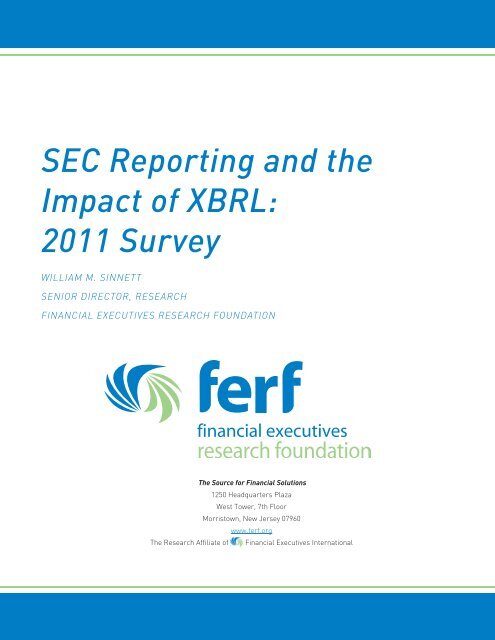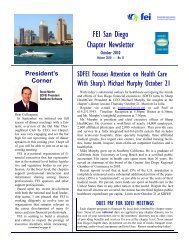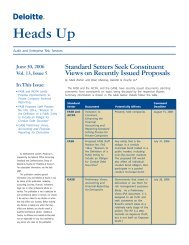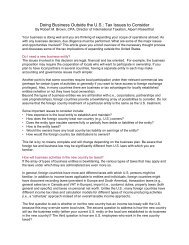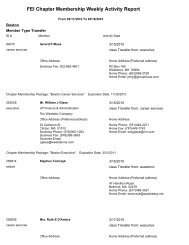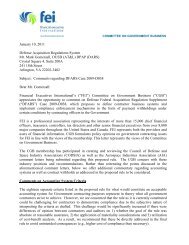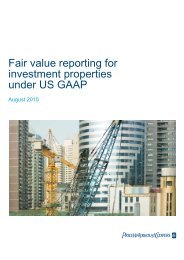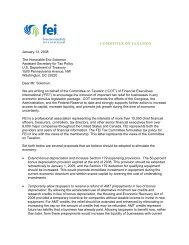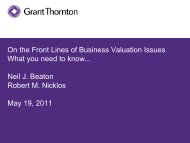SEC Reporting and the Impact of XBRL: 2011 Survey - Financial ...
SEC Reporting and the Impact of XBRL: 2011 Survey - Financial ...
SEC Reporting and the Impact of XBRL: 2011 Survey - Financial ...
You also want an ePaper? Increase the reach of your titles
YUMPU automatically turns print PDFs into web optimized ePapers that Google loves.
<strong>SEC</strong> <strong>Reporting</strong> <strong>and</strong> <strong>the</strong><br />
<strong>Impact</strong> <strong>of</strong> <strong>XBRL</strong>:<br />
<strong>2011</strong> <strong>Survey</strong><br />
WILLIAM M. SINNETT<br />
SENIOR DIRECTOR, RESEARCH<br />
FINANCIAL EXECUTIVES RESEARCH FOUNDATION<br />
The Source for <strong>Financial</strong> Solutions<br />
1250 Headquarters Plaza<br />
West Tower, 7th Floor<br />
Morristown, New Jersey 07960<br />
www.ferf.org<br />
The Research Affiliate <strong>of</strong> <strong>Financial</strong> Executives International
<strong>SEC</strong> REPORTING AND THE IMPACT OF <strong>XBRL</strong>:<br />
<strong>2011</strong> SURVEY<br />
TABLE OF CONTENTS<br />
Executive Summary 1<br />
Purpose <strong>and</strong> Design <strong>of</strong> <strong>Survey</strong> 2<br />
Pr<strong>of</strong>ile— <strong>Survey</strong> Respondents 4<br />
Size <strong>of</strong> <strong>SEC</strong> <strong>Reporting</strong> Team <strong>and</strong> Core Responsibilities 7<br />
<strong>SEC</strong> <strong>Reporting</strong> Filing Data 10<br />
<strong>SEC</strong> <strong>Reporting</strong> Practices 13<br />
<strong>XBRL</strong> Creation Approach 18<br />
Number <strong>of</strong> Hours to Create <strong>XBRL</strong> Reports 22<br />
<strong>XBRL</strong> Experiences 23<br />
<strong>Impact</strong> <strong>of</strong> <strong>XBRL</strong> on <strong>SEC</strong> Filing Date 27<br />
<strong>XBRL</strong> Providers 28<br />
“Pencils Down” Experience 29<br />
<strong>XBRL</strong> Provider Satisfaction 30<br />
Acknowledgements 32<br />
PAGE
Executive Summary<br />
For publicly-held companies that file reports with <strong>the</strong> U.S. Securities <strong>and</strong> Exchange Commission<br />
(<strong>SEC</strong>), <strong>the</strong> financial statements must be tagged using eXtensible Business <strong>Reporting</strong> Language<br />
(<strong>XBRL</strong>). <strong>XBRL</strong> tagging is now a key part <strong>of</strong> <strong>the</strong> financial statement production process. In many companies,<br />
this production process entails a number <strong>of</strong> different players using a variety <strong>of</strong> documents<br />
<strong>and</strong> spreadsheets, providing <strong>the</strong> opportunity for error, inconsistency <strong>and</strong> inflated costs.<br />
The <strong>SEC</strong> now requires tagging <strong>of</strong> quarterly <strong>and</strong> annual reports on Forms 10-Q <strong>and</strong> 10-K with <strong>XBRL</strong>.<br />
In <strong>the</strong>ir first year <strong>of</strong> compliance, companies must detail tag <strong>the</strong>ir face financial statements <strong>and</strong><br />
block tag <strong>the</strong>ir footnotes. Compliance in <strong>the</strong> second <strong>and</strong> following years is more challenging because<br />
detail tagging <strong>of</strong> face financial statements <strong>and</strong> footnotes is required.<br />
To find out how companies are complying with <strong>the</strong>se <strong>XBRL</strong> tagging requirements, FERF surveyed<br />
members <strong>of</strong> FEI <strong>and</strong> o<strong>the</strong>r financial statement preparers. Executives from 300 unique companies<br />
responded to <strong>the</strong> survey.<br />
Key Findings:<br />
• The most significant challenges mentioned in complying with <strong>the</strong> <strong>XBRL</strong> m<strong>and</strong>ate are getting<br />
educated on <strong>XBRL</strong> <strong>and</strong> addressing <strong>the</strong> review process.<br />
• <strong>XBRL</strong> had a limited impact on respondents <strong>SEC</strong> filing dates:<br />
• 72% <strong>of</strong> large accelerated filers (Tier 1 <strong>and</strong> Tier 2) reported one day or less delay due to <strong>XBRL</strong>; <strong>and</strong><br />
• Over 90% <strong>of</strong> Tier 3 filers reported one day or less delay due to <strong>XBRL</strong>.<br />
• The majority <strong>of</strong> respondents found that <strong>XBRL</strong> was ei<strong>the</strong>r somewhat or significantly easier <strong>the</strong> second<br />
time around.<br />
• Tier 1 <strong>and</strong> Tier 2 <strong>XBRL</strong> filers predicted a higher likelihood than Tier 3 <strong>XBRL</strong> filers <strong>of</strong> changing<br />
<strong>the</strong>ir <strong>XBRL</strong> process, with <strong>the</strong> vast majority <strong>of</strong> companies anticipating a change opting for an in-house<br />
s<strong>of</strong>tware solution.<br />
• In-house <strong>and</strong> built-in solutions continue to increase <strong>the</strong>ir significant market share.<br />
• Registrants using built-in solutions (s<strong>of</strong>tware solutions used by in-house reporting teams in which <strong>the</strong><br />
creation <strong>of</strong> <strong>the</strong> EDGAR document <strong>and</strong> <strong>XBRL</strong> instant report are fully integrated) are significantly more<br />
satisfied than those using o<strong>the</strong>r approaches.<br />
<strong>SEC</strong> REPORTING AND THE IMPACT OF <strong>XBRL</strong>: <strong>2011</strong> SURVEY<br />
EXECUTIVE SUMMARY -PAGE 1
Purpose <strong>and</strong> Design <strong>of</strong> <strong>Survey</strong><br />
The <strong>SEC</strong> <strong>Reporting</strong> <strong>and</strong> <strong>the</strong> <strong>Impact</strong> <strong>of</strong> <strong>XBRL</strong>: <strong>2011</strong> <strong>Survey</strong> addressed two aspects <strong>of</strong> financial<br />
reporting. The first set <strong>of</strong> survey questions requested operational details, including:<br />
• The size <strong>and</strong> composition <strong>of</strong> <strong>the</strong> financial reporting team; <strong>and</strong><br />
• The number <strong>of</strong> days necessary to complete <strong>and</strong> file financial reports with <strong>the</strong> <strong>SEC</strong>.<br />
The second section <strong>of</strong> <strong>the</strong> survey focused on respondents’ experience in meeting <strong>XBRL</strong> requirements,<br />
including:<br />
• The organization’s level <strong>of</strong> underst<strong>and</strong>ing <strong>and</strong> involvement in <strong>the</strong> <strong>XBRL</strong> tagging process;<br />
• The approach <strong>the</strong> organization took to implement an <strong>XBRL</strong> solution;<br />
• The type <strong>and</strong> amount <strong>of</strong> resources that <strong>the</strong> organization used <strong>and</strong> <strong>the</strong> amount <strong>of</strong> time that <strong>the</strong><br />
organization invested in creating, reviewing <strong>and</strong> submitting <strong>the</strong> <strong>XBRL</strong> reports to <strong>the</strong> <strong>SEC</strong>;<br />
• The actual <strong>and</strong> potential impact <strong>of</strong> <strong>the</strong> <strong>XBRL</strong> requirement on <strong>the</strong> organization’s ability to meet its<br />
filing deadlines, including any “pencils down” requirements <strong>and</strong> delays in filing dates;<br />
• Areas <strong>of</strong> greatest concern about <strong>XBRL</strong>;<br />
• The name <strong>of</strong> <strong>the</strong> company’s <strong>XBRL</strong> provider;<br />
• The company’s level <strong>of</strong> satisfaction with that provider; <strong>and</strong><br />
• Planned changes to <strong>the</strong> <strong>XBRL</strong> process.<br />
The survey was launched on July 19, <strong>2011</strong>, via e-mail to over 5,000 FEI members <strong>and</strong> o<strong>the</strong>r<br />
financial statement preparers. The survey was taken down on October 4, <strong>2011</strong>.<br />
We received a total <strong>of</strong> 321 responses to <strong>the</strong> survey, representing responses from 300 unique<br />
companies.<br />
The first set <strong>of</strong> questions requested specific information, including <strong>the</strong>:<br />
• Name <strong>and</strong> position <strong>of</strong> <strong>the</strong> person completing <strong>the</strong> survey;<br />
• Company name;<br />
• Ticker symbol; <strong>and</strong><br />
• E-mail address <strong>of</strong> reporting person.<br />
<strong>SEC</strong> REPORTING AND THE IMPACT OF <strong>XBRL</strong>: <strong>2011</strong> SURVEY<br />
PURPOSE AND DESIGN OF SURVEY (Continued) -PAGE 2
Personal <strong>and</strong> company information <strong>of</strong> all respondents will be protected. As stated in <strong>the</strong> survey,<br />
FERF:<br />
• Was collecting company specific information solely for <strong>the</strong> purpose <strong>of</strong> improving survey quality; <strong>and</strong><br />
• Would not publish or o<strong>the</strong>rwise disclose identifiable information without <strong>the</strong> express written<br />
permission <strong>of</strong> <strong>the</strong> respondent.<br />
FERF was thus able to:<br />
• Control for multiple responses from <strong>the</strong> same company;<br />
• Determine missing public information about <strong>the</strong> reporting company;<br />
• Request missing non-public information about <strong>the</strong> reporting company; <strong>and</strong><br />
• Request clarification or corrected information from <strong>the</strong> reporting company.<br />
<strong>SEC</strong> REPORTING AND THE IMPACT OF <strong>XBRL</strong>: <strong>2011</strong> SURVEY<br />
PURPOSE AND DESIGN OF SURVEY (Continued) -PAGE 3
Pr<strong>of</strong>ile- <strong>Survey</strong> Respondents<br />
Throughout this document, we summarize <strong>and</strong> present <strong>the</strong> survey responses by both <strong>the</strong> <strong>SEC</strong> filing<br />
status (large accelerated filer, accelerated filer, non–accelerated filer <strong>and</strong> smaller reporting company)<br />
<strong>and</strong> <strong>the</strong> <strong>XBRL</strong> filing status (Tier 1, Tier 2 <strong>and</strong> Tier 3) <strong>of</strong> <strong>the</strong> respondents.<br />
<strong>SEC</strong> Filing Status:<br />
• Large accelerated filer - public float <strong>of</strong> $700 million or more<br />
• Accelerated filer - public float between $75 million <strong>and</strong> $700 million<br />
• Non-accelerated filer - public float <strong>of</strong> less than $75 million<br />
• Smaller reporting company - a sub-set <strong>of</strong> non-accelerated filers<br />
Levels <strong>of</strong> <strong>XBRL</strong> <strong>Reporting</strong>:<br />
• Level 1 - text block tags applied to <strong>the</strong> notes to <strong>the</strong> financial statements (this is accompanied with<br />
detailed tagging <strong>of</strong> face statements)<br />
• Level 2 - text block tags applied to each significant accounting policy<br />
• Level 3 - text block tags applied to each table within <strong>the</strong> notes to <strong>the</strong> financial statements<br />
• Level 4 - detailed tags applied to each amount in each table within <strong>the</strong> notes to <strong>the</strong> financial<br />
statements<br />
<strong>XBRL</strong> Filing Status<br />
• Tier 1 filers have <strong>the</strong> most experience with <strong>XBRL</strong>. They include large accelerated filers with over<br />
$5 billion <strong>of</strong> public float, <strong>and</strong> began filing <strong>XBRL</strong> reports for <strong>the</strong> quarter ended June 30, 2009. They<br />
are currently in <strong>the</strong>ir second year <strong>of</strong> providing detailed <strong>XBRL</strong> reports, <strong>and</strong> are now in <strong>the</strong> third<br />
year <strong>of</strong> <strong>XBRL</strong> filings.<br />
• Tier 2 filers include all <strong>of</strong> <strong>the</strong> o<strong>the</strong>r large accelerated filers. They are currently in <strong>the</strong>ir first year<br />
<strong>of</strong> providing detailed <strong>XBRL</strong> reports <strong>and</strong> began filing <strong>XBRL</strong> for <strong>the</strong> June 2010 quarter.<br />
• Tier 3 filers include accelerated, non-accelerated <strong>and</strong> smaller reporting companies— <strong>the</strong> least<br />
experienced <strong>XBRL</strong> filers. Tier 3 filers are currently filing Level 1 <strong>XBRL</strong> reports <strong>and</strong> began filing<br />
<strong>XBRL</strong> <strong>the</strong> first time for <strong>the</strong> June <strong>2011</strong> quarter.<br />
<strong>SEC</strong> REPORTING AND THE IMPACT OF <strong>XBRL</strong>: <strong>2011</strong> SURVEY<br />
PROFILE- SURVEY RESPONDENTS (Continued) -PAGE 4
In general, companies that responded to this survey are larger <strong>and</strong> have more experience with <strong>XBRL</strong> than<br />
<strong>the</strong> population <strong>of</strong> publicly reporting companies, taken as a whole. For example,<br />
• Approximately 500 Tier 1 filers represent approximately 5% <strong>of</strong> all reporting companies, yet repre-<br />
sent 20% <strong>of</strong> <strong>the</strong> respondents <strong>of</strong> this survey.<br />
• Approximately 1,700 large accelerated filers represent 19% <strong>of</strong> reporting companies, yet repre-<br />
sent 58% <strong>of</strong> <strong>the</strong> respondents <strong>of</strong> this survey.<br />
Respondents by <strong>XBRL</strong> <strong>and</strong> <strong>SEC</strong> Filing Status<br />
<strong>XBRL</strong> Filing Status <strong>SEC</strong> Filing Status Number <strong>of</strong> Respondents % <strong>of</strong> Respondents<br />
Distribution <strong>of</strong> all<br />
2010 10-K Filers 1<br />
TIER 1 Large Accelerated Filer 59 20% 5%<br />
TIER 2 Large Accelerated Filer 112 38% 14%<br />
TIER 3 Accelerated Filer 70 23% 19%<br />
1 Source: LogixData<br />
<strong>XBRL</strong> Filing Status <strong>SEC</strong> Filing Status<br />
Non-Accelerated Filer 31 10% 13%<br />
Smaller <strong>Reporting</strong> Company 28 9% 49%<br />
300 100% 100%<br />
Revenue for <strong>the</strong> Most Recent Fiscal Year<br />
More Than<br />
$10 Billion<br />
$5 to $10<br />
Billion<br />
$1 to $5<br />
Billion<br />
Less Than<br />
$1 Billion<br />
Number <strong>of</strong><br />
Respondents<br />
TIER 1 Large Accelerated Filer 46% 25% 27% 2% 59<br />
TIER 2 Large Accelerated Filer 4% 12% 53% 31% 112<br />
TIER 3 Accelerated Filer 1% 6% 26% 67% 70<br />
Non-Accelerated Filer —% 10% 23% 67% 31<br />
Smaller <strong>Reporting</strong> Company —% —% —% 100% 28<br />
300<br />
<strong>SEC</strong> REPORTING AND THE IMPACT OF <strong>XBRL</strong>: <strong>2011</strong> SURVEY<br />
PROFILE- SURVEY RESPONDENTS (Continued) -PAGE 5
<strong>XBRL</strong> Filing Status <strong>SEC</strong> Filing Status<br />
Percent <strong>of</strong> Revenue from International Operations<br />
More Than<br />
50%<br />
31% to<br />
50%<br />
10% to<br />
30%<br />
Less Than<br />
10%<br />
Number <strong>of</strong><br />
Respondents<br />
TIER 1 Large Accelerated Filer 24% 21% 17% 38% 58<br />
TIER 2 Large Accelerated Filer 24% 13% 13% 50% 106<br />
TIER 3 Accelerated Filer 19% 10% 12% 59% 69<br />
<strong>XBRL</strong> Filing Status <strong>SEC</strong> Filing Status<br />
Non-Accelerated Filer 10% 6% 3% 81% 31<br />
Smaller <strong>Reporting</strong> Company 18% 4% 11% 68% 28<br />
Number <strong>of</strong> Reportable Business Segments<br />
Eight or<br />
More<br />
Five to<br />
Seven<br />
Three or<br />
Four<br />
One or<br />
Two<br />
292<br />
Number <strong>of</strong><br />
Respondents<br />
TIER 1 Large Accelerated Filer 5% 22% 19% 54% 59<br />
TIER 2 Large Accelerated Filer 2% 11% 25% 62% 109<br />
TIER 3 Accelerated Filer —% 6% 28% 66% 67<br />
Non-Accelerated Filer —% 6% 13% 81% 31<br />
Smaller <strong>Reporting</strong> Company —% 4% 21% 75% 28<br />
Number <strong>of</strong> Employees (Excluding Temporary or Seasonal Employees)<br />
<strong>XBRL</strong> Filing Status <strong>SEC</strong> Filing Status<br />
More Than<br />
100,000<br />
25,000 to<br />
100,000<br />
1,000 to<br />
25,000<br />
Less Than<br />
1,000<br />
294<br />
Number <strong>of</strong><br />
Respondents<br />
TIER 1 Large Accelerated Filer 10% 37% 51% 2% 59<br />
TIER 2 Large Accelerated Filer 2% 6% 74% 18% 111<br />
TIER 3 Accelerated Filer —% 2% 52% 46% 69<br />
Non-Accelerated Filer —% 10% 38% 52% 31<br />
Smaller <strong>Reporting</strong> Company —% —% 14% 86% 28<br />
298<br />
<strong>SEC</strong> REPORTING AND THE IMPACT OF <strong>XBRL</strong>: <strong>2011</strong> SURVEY<br />
PROFILE- SURVEY RESPONDENTS (Continued) -PAGE 6
Size <strong>of</strong> <strong>SEC</strong> <strong>Reporting</strong> Team <strong>and</strong> Core Responsibilities<br />
There was a wide range <strong>of</strong> responses from zero to 16 employees who spend substantially all <strong>of</strong> <strong>the</strong>ir time on<br />
<strong>SEC</strong> reporting matters. Companies that reported zero did so intentionally. Those companies stated that <strong>the</strong>ir<br />
financial reporting team h<strong>and</strong>les a range <strong>of</strong> responsibilities <strong>and</strong> does not spend substantially all <strong>of</strong> <strong>the</strong>ir time<br />
on <strong>SEC</strong> reporting matters.<br />
How many employees spend all or substantially all <strong>of</strong> <strong>the</strong>ir time on <strong>SEC</strong> reporting matters?<br />
<strong>XBRL</strong> Filing Status <strong>SEC</strong> Filing Status Mean Median Minimum Maximum<br />
Number <strong>of</strong><br />
Respondents<br />
TIER 1 Large Accelerated Filer 3 3 — 10 58<br />
TIER 2 Large Accelerated Filer 3 3 1 16 112<br />
TIER 3 Accelerated Filer 2 2 — 7 70<br />
Non-Accelerated Filer 2 1 — 7 31<br />
Smaller <strong>Reporting</strong> Company 1 1 — 3 28<br />
The size <strong>of</strong> <strong>SEC</strong> reporting teams for large accelerated filers are one or two persons larger, on average,<br />
than Tier 3 companies.<br />
If you augment your core <strong>SEC</strong> reporting team with additional resources at peak times,<br />
where do you source <strong>the</strong> additional resources?<br />
<strong>XBRL</strong><br />
Filing Status<br />
<strong>SEC</strong> Filing Status<br />
Employee(s)<br />
From O<strong>the</strong>r<br />
Departments<br />
Part-time<br />
Employees<br />
Consultants Outsourcing O<strong>the</strong>r<br />
299<br />
Number <strong>of</strong><br />
Respondents<br />
TIER 1 Large Accelerated Filer 81% 3% 16% 6% 13% 31<br />
TIER 2 Large Accelerated Filer 70% —% 19% 4% 23% 47<br />
TIER 3 Accelerated Filer 73% —% 21% 6% 15% 57<br />
Non–Accelerated Filer 84% —% 8% —% 8% 12<br />
Smaller <strong>Reporting</strong> Company 78% —% 33% 22% 11% 9<br />
Most companies utilize employees from o<strong>the</strong>r departments within <strong>the</strong> company at peak times. The<br />
percentages add up to more than 100% as many companies augment <strong>the</strong> core <strong>SEC</strong> reporting team from<br />
multiple sources.<br />
156<br />
<strong>SEC</strong> REPORTING AND THE IMPACT OF <strong>XBRL</strong>: <strong>2011</strong> SURVEY<br />
SIZE OF <strong>SEC</strong> REPORTING TEAM AND CORE RESPONSIBILITIES -PAGE 7
What are <strong>the</strong> core responsibilities <strong>of</strong> <strong>the</strong> <strong>SEC</strong> reporting team?<br />
TIER 1 TIER 2 TIER 3<br />
Large<br />
Accelerated<br />
Filer<br />
Large<br />
Accelerated<br />
Filer<br />
Accelerated<br />
Filer<br />
Non–<br />
Accelerated<br />
Filer<br />
Smaller<br />
<strong>Reporting</strong><br />
Company<br />
Form 10-K 100% 100% 100% 100% 100%<br />
Form 10-Q 100% 100% 100% 100% 100%<br />
<strong>XBRL</strong> 98% 100% 99% 100% 100%<br />
Earnings Press Release Support/ Form 8-K Support 95% 96% 90% 84% 86%<br />
Technical Accounting Research 76% 88% 99% 81% 82%<br />
Proxy Statement (Supporting Role in Partnership with<br />
Legal or Outside Counsel)<br />
66% 72% 64% 52% 43%<br />
Audit Committee <strong>and</strong>/or Board <strong>of</strong> Directors Packages 54% 61% 68% 55% 71%<br />
Acquisition <strong>and</strong> Disposition Support 51% 57% 38% 42% 29%<br />
Proxy Statement (Primary Responsibility) 7% 12% 25% 19% 39%<br />
O<strong>the</strong>r 37% 38% 36% 35% 32%<br />
Number <strong>of</strong> Respondents 59 112 69 31 28 299<br />
Many o<strong>the</strong>r areas <strong>of</strong> responsibility were mentioned (aggregated above with “O<strong>the</strong>r”) but <strong>the</strong> five most frequently<br />
mentioned were:<br />
• Stock-based compensation;<br />
• SOX / internal controls;<br />
• Consolidation;<br />
• Internal management reporting; <strong>and</strong><br />
• Close / accounting.<br />
Total<br />
<strong>SEC</strong> REPORTING AND THE IMPACT OF <strong>XBRL</strong>: <strong>2011</strong> SURVEY<br />
SIZE OF <strong>SEC</strong> REPORTING TEAM AND CORE RESPONSIBILITIES (Continued) -PAGE 8
Which <strong>of</strong> <strong>the</strong> following participate in <strong>the</strong> review process <strong>of</strong> <strong>the</strong> 10-K/10-Q?<br />
TIER 1 TIER 2 TIER 3<br />
Large<br />
Accelerated<br />
Filer<br />
Large<br />
Accelerated<br />
Filer<br />
Accelerated<br />
Filer<br />
Non–<br />
Accelerated<br />
Filer<br />
Smaller<br />
<strong>Reporting</strong><br />
Company<br />
Chief <strong>Financial</strong> Officer 97% 98% 99% 94% 96%<br />
Independent Auditors 98% 96% 94% 100% 96%<br />
Audit Committee 100% 95% 97% 94% 86%<br />
Controller/ CAO 97% 97% 96% 94% 79%<br />
Outside Counsel 73% 76% 89% 74% 79%<br />
Disclosure Committee 92% 84% 74% 74% 43%<br />
Tax 86% 81% 69% 58% 32%<br />
Business Unit Leaders 71% 64% 39% 39% 39%<br />
Treasury 85% 73% 31% 23% 11%<br />
<strong>Financial</strong> Planning & Analysis 51% 49% 33% 35% 21%<br />
Internal Audit Staff 51% 44% 24% 29% 11%<br />
Functional Group Leaders 56% 36% 14% 29% 11%<br />
Number <strong>of</strong> Respondents 59 112 70 31 28 300<br />
It is probable that some review processes are taking place outside <strong>of</strong> <strong>the</strong> view <strong>of</strong> <strong>the</strong> person completing <strong>the</strong><br />
survey or that <strong>the</strong>re were interpretation differences or survey errors as we assume that <strong>the</strong> CFO, audit committee<br />
<strong>and</strong> independent auditors, for example, are reviewing <strong>the</strong> filings at 100% <strong>of</strong> <strong>the</strong> respondent companies.<br />
Total<br />
<strong>SEC</strong> REPORTING AND THE IMPACT OF <strong>XBRL</strong>: <strong>2011</strong> SURVEY<br />
SIZE OF <strong>SEC</strong> REPORTING TEAM AND CORE RESPONSIBILITIES (Continued) -PAGE 9
<strong>SEC</strong> <strong>Reporting</strong> Filing Data<br />
Large accelerated filers typically require less time to produce <strong>and</strong> file <strong>the</strong>ir annual <strong>and</strong> quarterly reports<br />
than accelerated, non-accelerated <strong>and</strong> smaller reporting company filers. Actual days to file for <strong>the</strong> most<br />
recent filing were used in <strong>the</strong> analysis (instead <strong>of</strong> <strong>the</strong> survey data) where available <strong>and</strong> was sourced from<br />
LogixData. This was attributed to ranges <strong>of</strong> responses provided by many companies- actual data was used<br />
for a more reliable analysis.<br />
<strong>XBRL</strong><br />
Filing Status<br />
Number <strong>of</strong> Days After Year-End to File Form 10-K<br />
<strong>SEC</strong> Filing Status Mean Median Minimum Maximum Due Date<br />
Number <strong>of</strong><br />
Respondents<br />
TIER 1 Large Accelerated Filer 53 55 28 60 60 59<br />
TIER 2 Large Accelerated Filer 55 56 33 60 60 112<br />
TIER 3 Accelerated Filer 63 65 38 75 75 70<br />
<strong>XBRL</strong><br />
Filing Status<br />
Non–Accelerated Filer 71 65 40 90 90 31<br />
Smaller <strong>Reporting</strong> Company 75 72 47 90 90 28<br />
Number <strong>of</strong> Days After Quarter-End to File Form 10-Q<br />
<strong>SEC</strong> Filing Status Mean Median Minimum Maximum Due Date<br />
300<br />
Number <strong>of</strong><br />
Respondents<br />
TIER 1 Large Accelerated Filer 33 34 20 40 40 59<br />
TIER 2 Large Accelerated Filer 34 36 20 40 40 112<br />
TIER 3 Accelerated Filer 35 36 26 40 40 70<br />
Non–Accelerated Filer 41 42 32 45 45 31<br />
Smaller <strong>Reporting</strong> Company 41 42 26 45 45 28<br />
300<br />
<strong>SEC</strong> REPORTING AND THE IMPACT OF <strong>XBRL</strong>: <strong>2011</strong> SURVEY<br />
<strong>SEC</strong> REPORTING FILING DATA -PAGE 10
<strong>XBRL</strong><br />
Filing Status<br />
Number <strong>of</strong> Days After Year-End to Report Earnings Release on Form 8-K<br />
<strong>SEC</strong> Filing Status Mean Median Minimum Maximum<br />
Number <strong>of</strong><br />
Respondents<br />
TIER 1 Large Accelerated Filer 34 34 14 58 59<br />
TIER 2 Large Accelerated Filer 41 41 11 60 111<br />
TIER 3 Accelerated Filer 49 48 26 75 67<br />
<strong>XBRL</strong><br />
Filing Status<br />
Non–Accelerated Filer 55 58 25 90 26<br />
Smaller <strong>Reporting</strong> Company 60 56 25 90 23<br />
Number <strong>of</strong> Days After Quarter-End to Report Earnings Release on Form 8-K<br />
<strong>SEC</strong> Filing Status Mean Median Minimum Maximum<br />
286<br />
Number <strong>of</strong><br />
Respondents<br />
TIER 1 Large Accelerated Filer 27 27 14 40 59<br />
TIER 2 Large Accelerated Filer 29 28 11 40 110<br />
TIER 3 Accelerated Filer 31 32 17 40 67<br />
Non–Accelerated Filer 38 40 25 45 27<br />
Smaller <strong>Reporting</strong> Company 35 35 20 45 23<br />
286<br />
<strong>SEC</strong> REPORTING AND THE IMPACT OF <strong>XBRL</strong>: <strong>2011</strong> SURVEY<br />
<strong>SEC</strong> REPORTING FILING DATA (Continued) -PAGE 11
0 Days (8-K <strong>and</strong> 10-K on <strong>the</strong><br />
Same Day)<br />
Number <strong>of</strong> Days From Earnings Release on Form 8-K to Filing <strong>of</strong> 10-K<br />
TIER 1 TIER 2 TIER 3<br />
Large<br />
Accelerated<br />
Filer<br />
Large<br />
Accelerated<br />
Filer<br />
Accelerated<br />
Filer<br />
Non–<br />
Accelerated<br />
Filer<br />
Smaller<br />
<strong>Reporting</strong><br />
Company<br />
3% 13% 21% 37% 29%<br />
1-5 Days 9% 22% 16% 13% 19%<br />
6-10 Days 15% 12% 6% 13% —%<br />
11-15 Days 14% 10% 19% 4% 5%<br />
16-20 Days 15% 10% 10% 8% 10%<br />
21-30 Days 29% 22% 15% 4% 9%<br />
> 30 Days 15% 11% 13% 21% 28%<br />
Number <strong>of</strong> Respondents 59 111 68 24 21 283<br />
0 Days (8-K <strong>and</strong> 10-Q on <strong>the</strong><br />
Same Day)<br />
Number <strong>of</strong> Days From Earnings Release on Form 8-K to Filing <strong>of</strong> 10-Q<br />
TIER 1 TIER 2 TIER 3<br />
Large<br />
Accelerated<br />
Filer<br />
Large<br />
Accelerated<br />
Filer<br />
Accelerated<br />
Filer<br />
Non–<br />
Accelerated<br />
Filer<br />
Smaller<br />
<strong>Reporting</strong><br />
Company<br />
10% 35% 43% 36% 29%<br />
1-5 Days 39% 27% 22% 44% 29%<br />
6-10 Days 30% 15% 24% 16% 5%<br />
11-15 Days 12% 15% 7% 4% 24%<br />
16-20 Days 7% 5% 3% — % 4%<br />
> 20 Days 2% 3% 1% —% 9%<br />
Number <strong>of</strong> Respondents 59 111 68 25 21 284<br />
Total<br />
Total<br />
<strong>SEC</strong> REPORTING AND THE IMPACT OF <strong>XBRL</strong>: <strong>2011</strong> SURVEY<br />
<strong>SEC</strong> REPORTING FILING DATA (Continued) -PAGE 12
<strong>SEC</strong> <strong>Reporting</strong> Practices<br />
What issue(s) do you consider your biggest bottleneck in <strong>the</strong> reporting function?<br />
TIER 1 TIER 2 TIER 3<br />
Large<br />
Accelerated<br />
Filer<br />
Large<br />
Accelerated<br />
Filer<br />
Accelerated<br />
Filer<br />
Non–<br />
Accelerated<br />
Filer<br />
Smaller<br />
<strong>Reporting</strong><br />
Company<br />
<strong>XBRL</strong> 45% 38% 5% —% 4%<br />
Review process 16% 25% 28% 22% 26%<br />
Timely collection <strong>of</strong> data 12% 16% 20% 13% 35%<br />
Closing <strong>the</strong> books 8% 10% 23% 26% 17%<br />
Staffing/Tight time schedules 12% 9% 7% 13% —%<br />
Late changes 6% 10% 7% 13% 9%<br />
Auditor review process 4% 7% 3% 9% 17%<br />
Systems —% 3% 8% 4% 13%<br />
Tax Entries 4% 2% 5% —% —%<br />
MD&A 4% 2% 2% —% —%<br />
Consolidation 4% 2% 5% —% —%<br />
O<strong>the</strong>r 2% 3% —% —% 4%<br />
Number <strong>of</strong> Respondents 51 88 60 23 23 245<br />
Percentages are based on <strong>the</strong> number <strong>of</strong> respondents indicating a particular bottleneck divided by <strong>the</strong><br />
number <strong>of</strong> respondents in <strong>the</strong> <strong>XBRL</strong> <strong>and</strong> <strong>SEC</strong> filing group answering this question— column percentages<br />
may add up to more than 100%.<br />
The above table was compiled from narrative responses <strong>and</strong> overlap was noted among <strong>the</strong> various categories.<br />
Representative comments are highlighted in <strong>the</strong> table below. There was a broad range <strong>of</strong> issues<br />
mentioned as significant reporting bottlenecks.<br />
• <strong>XBRL</strong> was mentioned by 40% <strong>of</strong> large accelerated filers (aggregate <strong>of</strong> Tier 1 <strong>and</strong> Tier 2 companies).<br />
• Tier 3 <strong>XBRL</strong> filers were significantly less likely to consider <strong>XBRL</strong> as a significant bottleneck.<br />
• The review process is a frequently mentioned reporting bottleneck across <strong>SEC</strong> filing categories <strong>and</strong> was<br />
<strong>the</strong> most frequently mentioned issue by Tier 3 <strong>XBRL</strong> filers.<br />
• Timely collection <strong>of</strong> data <strong>and</strong> closing <strong>the</strong> books were also <strong>of</strong>ten mentioned by companies across all <strong>SEC</strong><br />
filing categories --collection <strong>of</strong> “accurate” data was frequently mentioned.<br />
Total<br />
<strong>SEC</strong> REPORTING AND THE IMPACT OF <strong>XBRL</strong>: <strong>2011</strong> SURVEY<br />
<strong>SEC</strong> REPORTING PRACTICES -PAGE 13
Significant Bottlenecks to <strong>the</strong> <strong>Reporting</strong> Process<br />
Summary Bottleneck Representative Detailed Comments<br />
<strong>XBRL</strong><br />
Review process<br />
Timely collection <strong>of</strong> data<br />
Closing <strong>the</strong> books<br />
Staffing/ tight time<br />
schedule<br />
Late changes<br />
Auditor review process<br />
Systems<br />
<strong>XBRL</strong> compliance, <strong>XBRL</strong> tagging, outsourcing <strong>of</strong> tagging process for <strong>XBRL</strong>, slow<br />
turnaround time by printer/<strong>XBRL</strong> service provider, <strong>the</strong> <strong>XBRL</strong> turnaround from outside<br />
providers<br />
Distribution <strong>and</strong> review process, review <strong>of</strong> documents by <strong>the</strong> executive team, legal review,<br />
both external <strong>and</strong> internal, coordinating reviews <strong>and</strong> comments<br />
Having all departments meet internal time-lines, ga<strong>the</strong>ring information from many different<br />
sources (employees <strong>and</strong>/or systems), timely reporting by business units, obtaining<br />
timely <strong>and</strong> accurate information from internal sources<br />
Finalizing <strong>the</strong> close process, accounting not getting <strong>the</strong> books closed quickly <strong>and</strong><br />
accurately, timely <strong>and</strong> accurate results from accounting, accounting close <strong>and</strong> late<br />
adjustments<br />
Insufficient headcount <strong>and</strong> a long close cycle, small team responsible for <strong>SEC</strong> reporting,<br />
which can cause <strong>the</strong> bottleneck, capacity constraints - volume <strong>of</strong> work at quarter<br />
end, lack <strong>of</strong> resources, getting financial results <strong>and</strong> o<strong>the</strong>r operational metrics in a<br />
timely manner<br />
Post closing adjustments, late changes to underlying financial information, unforeseen<br />
<strong>and</strong>/or late accounting issues, processing changes from executives <strong>and</strong> auditors<br />
Auditor review, audit timing, late response from external auditors, getting auditor sign-<strong>of</strong>f<br />
on earnings release, audit team review <strong>of</strong> documents<br />
Level <strong>of</strong> manual effort to complete objectives, manual processes / resource constraints,<br />
Word/Excel documents updating <strong>and</strong> <strong>the</strong>n making sure <strong>the</strong>y are ready to EDGARize, lack<br />
<strong>of</strong> a good reporting tool, <strong>the</strong> manual nature <strong>of</strong> <strong>the</strong> 10-Q/10-K drafting<br />
Tax entries Tax provision, outsourced tax provision, finalization <strong>of</strong> tax entries (provision, deferred)<br />
MD&A<br />
Consolidation<br />
O<strong>the</strong>r<br />
MD&A explanations from <strong>the</strong> various operational accounting groups, getting fluctuation<br />
analyses from <strong>the</strong> operating groups to explain variances <strong>and</strong> trends, variance analysis<br />
after books closed to prepare MD&A<br />
Consolidation <strong>of</strong> subsidiaries, consolidation, waiting on subsidiary financial statements,<br />
consolidation <strong>of</strong> entities in ERP system<br />
Version control, preparing committee materials, increasing complexity <strong>of</strong> new rules <strong>and</strong><br />
regulations, communication, implementation <strong>of</strong> complex new accounting rules<br />
<strong>SEC</strong> REPORTING AND THE IMPACT OF <strong>XBRL</strong>: <strong>2011</strong> SURVEY<br />
<strong>SEC</strong> REPORTING PRACTICES (Continued) -PAGE 14
Does your company use non-GAAP financial measures in its earnings press release?<br />
<strong>XBRL</strong> Filing Status <strong>SEC</strong> Filing Status Yes No<br />
Number <strong>of</strong><br />
Respondents<br />
TIER 1 Large Accelerated Filer 75% 25% 59<br />
TIER 2 Large Accelerated Filer 85% 15% 111<br />
TIER 3 Accelerated Filer 75% 25% 69<br />
Non–Accelerated Filer 86% 14% 29<br />
Smaller <strong>Reporting</strong> Company 36% 64% 28<br />
Does your company use non-GAAP financial measures in MD&A?<br />
<strong>XBRL</strong> Filing Status <strong>SEC</strong> Filing Status Yes No<br />
296<br />
Number <strong>of</strong><br />
Respondents<br />
TIER 1 Large Accelerated Filer 51% 49% 59<br />
TIER 2 Large Accelerated Filer 48% 52% 111<br />
TIER 3 Accelerated Filer 39% 61% 70<br />
Non–Accelerated Filer 65% 35% 31<br />
Smaller <strong>Reporting</strong> Company 15% 85% 27<br />
Does your company issue guidance?<br />
<strong>XBRL</strong> Filing Status <strong>SEC</strong> Filing Status Yes No<br />
298<br />
Number <strong>of</strong><br />
Respondents<br />
TIER 1 Large Accelerated Filer 72% 28% 58<br />
TIER 2 Large Accelerated Filer 80% 20% 110<br />
TIER 3 Accelerated Filer 54% 46% 70<br />
Non–Accelerated Filer 37% 63% 30<br />
Smaller <strong>Reporting</strong> Company 25% 75% 28<br />
296<br />
<strong>SEC</strong> REPORTING AND THE IMPACT OF <strong>XBRL</strong>: <strong>2011</strong> SURVEY<br />
<strong>SEC</strong> REPORTING PRACTICES (Continued) -PAGE 15
Does your company hold an analyst call after earnings release?<br />
<strong>XBRL</strong> Filing Status <strong>SEC</strong> Filing Status Yes No Number <strong>of</strong> Respondents<br />
TIER 1 Large Accelerated Filer 98% 2% 59<br />
TIER 2 Large Accelerated Filer 95% 5% 112<br />
TIER 3 Accelerated Filer 90% 10% 70<br />
Non–Accelerated Filer 67% 33% 30<br />
Smaller <strong>Reporting</strong> Company 54% 46% 28<br />
How many hours per quarter do you spend supporting <strong>the</strong> press release process?<br />
<strong>XBRL</strong><br />
Filing Status<br />
<strong>SEC</strong> Filing Status<br />
Fewer than<br />
10 hours<br />
10 to 20<br />
hours<br />
21 to 30<br />
hours<br />
31 to 40<br />
hours<br />
More than<br />
40 hours<br />
299<br />
Number <strong>of</strong><br />
Respondents<br />
TIER 1 Large Accelerated Filer 8% 10% 17% 19% 46% 59<br />
TIER 2 Large Accelerated Filer 9% 25% 15% 11% 40% 112<br />
TIER 3 Accelerated Filer 14% 26% 17% 13% 30% 69<br />
Non–Accelerated Filer 24% 24% 7% 17% 28% 29<br />
Smaller <strong>Reporting</strong> Company 43% 28% 7% 11% 11% 28<br />
How many working days does it take to close your books for a typical quarter-end?<br />
<strong>XBRL</strong><br />
Filing Status<br />
<strong>SEC</strong> Filing Status Average Minimum Maximum Median Number <strong>of</strong> Respondents<br />
TIER 1 Large Accelerated Filer 9 3 27 8 48<br />
TIER 2 Large Accelerated Filer 9 3 40 8 97<br />
TIER 3 Accelerated Filer 11 4 30 10 60<br />
Non–Accelerated Filer 10 3 20 10 31<br />
Smaller <strong>Reporting</strong> Company 12 1 30 10 23<br />
297<br />
259<br />
<strong>SEC</strong> REPORTING AND THE IMPACT OF <strong>XBRL</strong>: <strong>2011</strong> SURVEY<br />
<strong>SEC</strong> REPORTING PRACTICES (Continued) -PAGE 16
How many working days does it take to close your books for a typical year-end?<br />
<strong>XBRL</strong><br />
Filing Status<br />
<strong>SEC</strong> Filing Status Average Minimum Maximum Median Number <strong>of</strong> Respondents<br />
TIER 1 Large Accelerated Filer 12 3 40 9 48<br />
TIER 2 Large Accelerated Filer 11 5 55 10 97<br />
TIER 3 Accelerated Filer 16 1 53 14 59<br />
Non–Accelerated Filer 15 5 34 14 30<br />
Smaller <strong>Reporting</strong> Company 20 2 60 13 23<br />
Do you prepare a preliminary draft <strong>of</strong> <strong>the</strong><br />
Form 10-K/ 10-Q prior to quarter-end?<br />
<strong>XBRL</strong> Filing Status <strong>SEC</strong> Filing Status Yes No Number <strong>of</strong> Respondents<br />
TIER 1 Large Accelerated Filer 84% 16% 58<br />
TIER 2 Large Accelerated Filer 85% 15% 110<br />
TIER 3 Accelerated Filer 81% 19% 69<br />
Non–Accelerated Filer 71% 29% 31<br />
Smaller <strong>Reporting</strong> Company 64% 36% 28<br />
257<br />
296<br />
<strong>SEC</strong> REPORTING AND THE IMPACT OF <strong>XBRL</strong>: <strong>2011</strong> SURVEY<br />
<strong>SEC</strong> REPORTING PRACTICES (Continued) -PAGE 17
<strong>XBRL</strong> Creation Approach<br />
The key aspects <strong>of</strong> <strong>the</strong> <strong>XBRL</strong> implementation process include:<br />
• Mapping - matching <strong>the</strong> financial line items in <strong>the</strong> financial statements to <strong>the</strong> appropriate U.S. GAAP taxonomy<br />
concepts (tags).<br />
• Tagging - applying <strong>the</strong> tags selected to <strong>the</strong> financial data <strong>and</strong> setting appropriate <strong>XBRL</strong> attributes (decimals, units,<br />
negated values, dates, etc).<br />
• Review - <strong>XBRL</strong> technical validation, rendering, QA, etc.<br />
Most <strong>of</strong> <strong>the</strong> companies reported that <strong>the</strong>y performed at least part <strong>of</strong> <strong>the</strong> <strong>XBRL</strong> process in-house.<br />
<strong>XBRL</strong> Filing<br />
Status<br />
How did your organization create <strong>and</strong> submit <strong>the</strong> <strong>XBRL</strong>-formatted<br />
financial statement exhibits?<br />
<strong>SEC</strong> Filing Status<br />
Outsourced<br />
entire<br />
process<br />
Outsourced part<br />
<strong>of</strong> <strong>the</strong> process, but<br />
mapped internally<br />
Used hired consultants/advisors<br />
<strong>and</strong><br />
a s<strong>of</strong>tware tool<br />
Used internal<br />
staff <strong>and</strong> a<br />
s<strong>of</strong>tware tool<br />
Number <strong>of</strong><br />
Respondents<br />
TIER 1 Large Accelerated Filer 41% 17% 18% 24% 59<br />
TIER 2 Large Accelerated Filer 41% 21% 16% 22% 108<br />
TIER 3 Accelerated Filer 33% 11% 16% 40% 63<br />
Non-Accelerated Filer 36% 11% 14% 39% 28<br />
Smaller <strong>Reporting</strong> Company 44% 12% 12% 32% 25<br />
283<br />
<strong>SEC</strong> REPORTING AND THE IMPACT OF <strong>XBRL</strong>: <strong>2011</strong> SURVEY<br />
<strong>XBRL</strong> CREATION APPROACH -PAGE 18
<strong>XBRL</strong> Filing Status<br />
How did your organization create <strong>and</strong> submit <strong>the</strong> <strong>XBRL</strong>-formatted<br />
financial statement exhibits?<br />
Outsourced<br />
Entire Process<br />
Outsourced Part<br />
<strong>of</strong> <strong>the</strong> Process, but<br />
Mapped Internally<br />
Used Hired<br />
Consultants/ Advisors<br />
<strong>and</strong> a S<strong>of</strong>tware Tool<br />
Used Internal Staff<br />
<strong>and</strong> a S<strong>of</strong>tware Tool<br />
Number <strong>of</strong><br />
Respondents<br />
Clarity 7% —% 7% 86% 14<br />
Donnelley 72% 28% —% —% 90<br />
Merrill 72% 14% 7% 7% 14<br />
Rivet 46% 31% —% 23% 13<br />
Thomson Reuters 25% 20% 25% 30% 20<br />
WebFilings 17% 4% 31% 48% 114<br />
O<strong>the</strong>r 33% 33% 23% 11% 9<br />
Did Not State 11% 33% 11% 45% 9<br />
283<br />
There was some range in how respondents indicated using a given solution. For example, <strong>of</strong> <strong>the</strong> 14<br />
respondents to this question who reported using Clarity, 12 respondents (86%) indicated using internal<br />
staff <strong>and</strong> <strong>the</strong> s<strong>of</strong>tware tool, one respondent (7%) reported using Clarity’s s<strong>of</strong>tware tool along with outside<br />
consultants to provide <strong>XBRL</strong> services <strong>and</strong> one respondent (7%) which reported using Clarity described <strong>the</strong><br />
process as fully outsourced.<br />
The great majority <strong>of</strong> <strong>the</strong> companies using RR Donnelley <strong>and</strong> Merrill indicated that <strong>the</strong>y outsourced <strong>the</strong><br />
<strong>XBRL</strong> process while companies using Clarity overwhelmingly indicated that <strong>the</strong>y used a s<strong>of</strong>tware tool<br />
internally. Companies using Rivet, Thomson Reuters <strong>and</strong> WebFilings had more distributed responses,<br />
as <strong>the</strong>se <strong>of</strong>ferings allow for a range <strong>of</strong> services, from complete outsourcing <strong>of</strong> pr<strong>of</strong>essional services to<br />
self–sufficiency using s<strong>of</strong>tware internally (in–house).<br />
Will you continue <strong>the</strong> same process going forward?<br />
<strong>XBRL</strong> Filing Status <strong>SEC</strong> Filing Status Yes No<br />
Don’t<br />
Know<br />
Number <strong>of</strong> Respondents<br />
TIER 1 Large Accelerated Filer 49% 34% 17% 59<br />
TIER 2 Large Accelerated Filer 45% 38% 17% 109<br />
TIER 3 Accelerated Filer 74% 11% 15% 61<br />
Non–Accelerated Filer 68% 18% 14% 28<br />
Smaller <strong>Reporting</strong> Company 88% 4% 8% 25<br />
Tier 1 <strong>and</strong> 2 <strong>XBRL</strong> filers, who have <strong>the</strong> most experience with <strong>XBRL</strong>, were significantly more likely to predict<br />
a change in <strong>XBRL</strong> process going forward versus Tier 3 filers who have not yet had experience with<br />
detailed tagging. Of <strong>the</strong> respondents who indicated that <strong>the</strong>y would change <strong>the</strong>ir process (“No” answer<br />
above), <strong>the</strong> vast majority projected adoption <strong>of</strong> an in-house s<strong>of</strong>tware solution.<br />
282<br />
<strong>SEC</strong> REPORTING AND THE IMPACT OF <strong>XBRL</strong>: <strong>2011</strong> SURVEY<br />
<strong>XBRL</strong> CREATION APPROACH (Continued) -PAGE 19
<strong>XBRL</strong> Filing Status <strong>SEC</strong> Filing Status<br />
If you do not plan to continue <strong>the</strong> same process,<br />
what part <strong>of</strong> <strong>the</strong> process will you change to?<br />
Bringing In-House/<br />
S<strong>of</strong>tware Solution<br />
Outsourcing Undecided<br />
Number <strong>of</strong><br />
Respondents<br />
TIER 1 Large Accelerated Filer 100% —% —% 16<br />
TIER 2 Large Accelerated Filer 90% 5% 5% 39<br />
TIER 3 Accelerated Filer 100% —% —% 10<br />
Non-Accelerated Filer 100% —% —% 5<br />
Smaller <strong>Reporting</strong> Company 100% —% —% 1<br />
71<br />
There were two Tier 2 filers that indicated an outsourcing change. Both plan to change from one outsourced<br />
provider to ano<strong>the</strong>r. Based on companies’ future plans for <strong>XBRL</strong> compliance, <strong>the</strong>re does not appear<br />
to be any reversal <strong>of</strong> <strong>the</strong> trend from outsourcing <strong>XBRL</strong> to <strong>the</strong> use <strong>of</strong> in-house s<strong>of</strong>tware solutions.<br />
<strong>SEC</strong> REPORTING AND THE IMPACT OF <strong>XBRL</strong>: <strong>2011</strong> SURVEY<br />
<strong>XBRL</strong> CREATION APPROACH (Continued) -PAGE 20
What resources did you use when developing <strong>XBRL</strong>-formatted financial statements?<br />
TIER 1 TIER 2 TIER 3<br />
Large<br />
Accelerated<br />
Filer<br />
Large<br />
Accelerated<br />
Filer<br />
Accelerated<br />
Filer<br />
Non–<br />
Accelerated<br />
Filer<br />
Smaller<br />
<strong>Reporting</strong><br />
Company<br />
<strong>XBRL</strong> U.S. GAAP taxonomies 88% 85% 80% 82% 56%<br />
Service or tool provider support 71% 72% 67% 64% 48%<br />
Training rovided by s<strong>of</strong>tware or<br />
service providers<br />
Review <strong>of</strong> competitor or industry<br />
public company filings<br />
64% 60% 67% 61% 52%<br />
49% 69% 62% 64% 36%<br />
Educational webinar 61% 59% 63% 50% 40%<br />
<strong>XBRL</strong> U.S. preparers guide 42% 41% 32% 29% 8%<br />
<strong>SEC</strong> resources 47% 37% 32% 11% 16%<br />
<strong>XBRL</strong> U.S. FAQs or o<strong>the</strong>r web<br />
tools (sample instances, articles,<br />
etc.)<br />
39% 23% 30% 11% 20%<br />
In-person training session 31% 27% 25% 29% 4%<br />
EDGAR filer manual 39% 28% 18% 18% 8%<br />
Filing agent resources 20% 18% 12% 11% 20%<br />
Help from auditor 10% 4% 3% 4% —%<br />
Direct questions to <strong>XBRL</strong> U.S.<br />
personnel<br />
5% 2% 3% —% 4%<br />
Number <strong>of</strong> Respondents 59 109 60 28 25 281<br />
Total<br />
<strong>SEC</strong> REPORTING AND THE IMPACT OF <strong>XBRL</strong>: <strong>2011</strong> SURVEY<br />
<strong>XBRL</strong> CREATION APPROACH (Continued) -PAGE 21
Number <strong>of</strong> Hours to Create <strong>XBRL</strong> Reports<br />
Less than half <strong>of</strong> large accelerated filers reported that <strong>the</strong>y incurred more than 80 hours to review <strong>and</strong><br />
coordinate with <strong>the</strong>ir third-party service provider for <strong>the</strong>ir Level 4 detailed <strong>XBRL</strong> reports. <strong>XBRL</strong> reports<br />
prepared in-house required more staff time than outsourced filings, reflecting <strong>the</strong> broader role taken on<br />
by in-house teams. Tier 3 filers reported a lower number <strong>of</strong> hours than Tier 1 <strong>and</strong> 2 filers which is reflective<br />
<strong>of</strong> <strong>the</strong> reduced complexity <strong>of</strong> <strong>the</strong>ir first year <strong>XBRL</strong> filings.<br />
If outsourced, how many hours did it take your company to review <strong>and</strong> coordinate<br />
with <strong>the</strong> 3rd party service provider to submit <strong>the</strong> <strong>XBRL</strong> files to <strong>the</strong> <strong>SEC</strong>?<br />
<strong>XBRL</strong> Filing Status <strong>SEC</strong> Filing Status<br />
Less than 40<br />
hours<br />
41-80<br />
hours<br />
81-120<br />
hours<br />
More than<br />
120 hours<br />
Number <strong>of</strong><br />
Respondents<br />
TIER 1 Large Accelerated Filer 15% 41% 12% 32% 41<br />
TIER 2 Large Accelerated Filer 25% 30% 15% 30% 77<br />
TIER 3 Accelerated Filer 52% 27% 15% 6% 33<br />
Non-Accelerated Filer 47% 29% 6% 18% 17<br />
Smaller <strong>Reporting</strong> Company 60% 26% 7% 7% 15<br />
183<br />
If in-house, how many hours did it take your organization to<br />
create, review <strong>and</strong> submit <strong>the</strong> <strong>XBRL</strong> files to <strong>the</strong> <strong>SEC</strong>?<br />
<strong>XBRL</strong> Filing Status <strong>SEC</strong> Filing Status<br />
Less than 40<br />
hours<br />
41-80<br />
hours<br />
81-120<br />
hours<br />
More than<br />
120 hours<br />
Number <strong>of</strong><br />
Respondents<br />
TIER 1 Large Accelerated Filer 8% 31% 23% 38% 26<br />
TIER 2 Large Accelerated Filer 18% 14% 16% 52% 51<br />
TIER 3 Accelerated Filer 13% 25% 34% 28% 32<br />
Non-Accelerated Filer 19% 44% 25% 12% 16<br />
Smaller <strong>Reporting</strong> Company 58% 33% —% 9% 12<br />
137<br />
<strong>SEC</strong> REPORTING AND THE IMPACT OF <strong>XBRL</strong>: <strong>2011</strong> SURVEY<br />
NUMBER OF HOURS TO CREATE <strong>XBRL</strong> REPORTS -PAGE 22
<strong>XBRL</strong> Experiences<br />
What questions or concerns do you have now that you have done <strong>XBRL</strong> tagging?<br />
(Choose all that apply)<br />
How to increase efficiences in creation,<br />
review <strong>and</strong> submission<br />
Ongoing cost <strong>and</strong> difficulty <strong>of</strong> <strong>XBRL</strong><br />
creation <strong>and</strong> submission<br />
How to better define <strong>and</strong> control <strong>the</strong><br />
process<br />
More information on how to do detailed<br />
tagging<br />
Resource availability to meet ongoing<br />
processes<br />
Developments regarding auditors<br />
responsibility for <strong>XBRL</strong>-formatted<br />
financial statements<br />
Risk/liability for having <strong>the</strong> same<br />
financials available to <strong>the</strong> public in two<br />
different formats<br />
What is <strong>the</strong> readiness <strong>of</strong> market for<br />
financial analysis s<strong>of</strong>tware tool development<br />
for individuals <strong>and</strong> small company<br />
users<br />
<strong>Reporting</strong> package <strong>and</strong> management<br />
information s<strong>of</strong>tware tool availability<br />
Not being able to use <strong>the</strong> grace period in<br />
subsequent filings<br />
How to put a rendered version <strong>of</strong> my<br />
<strong>XBRL</strong> financials on my site<br />
TIER 1 TIER 2 TIER 3<br />
Large<br />
Accelerated<br />
Filer<br />
Large<br />
Accelerated<br />
Filer<br />
Accelerated<br />
Filer<br />
Non–<br />
Accelerated<br />
Filer<br />
Smaller<br />
<strong>Reporting</strong><br />
Company<br />
91% 92% 78% 75% 68%<br />
53% 60% 46% 46% 53%<br />
53% 51% 52% 29% 37%<br />
19% 25% 90% 67% 100%<br />
45% 52% 36% 33% 32%<br />
42% 40% 36% 21% 37%<br />
49% 35% 28% 38% 16%<br />
25% 20% 28% 17% 16%<br />
13% 22% 14% 4% 11%<br />
8% 8% 8% 4% 11%<br />
4% 5% 12% 4% 21%<br />
Number <strong>of</strong> Respondents 53 96 50 24 19 242<br />
Total<br />
<strong>SEC</strong> REPORTING AND THE IMPACT OF <strong>XBRL</strong>: <strong>2011</strong> SURVEY<br />
<strong>XBRL</strong> EXPERIENCES -PAGE 23
<strong>XBRL</strong> Filing<br />
Status<br />
What is your familiarity with eXtensible Business <strong>Reporting</strong> Language (<strong>XBRL</strong>)?<br />
<strong>SEC</strong> Filing Status<br />
Expert<br />
Knowledge<br />
Advanced<br />
Knowledge<br />
Basic<br />
Knowledge<br />
Some<br />
Knowledge<br />
Does Not<br />
Apply<br />
Number <strong>of</strong><br />
Respondents<br />
TIER 1 Large Accelerated Filer 17% 59% —% 24% —% 59<br />
TIER 2 Large Accelerated Filer 11% 59% 5% 25% —% 111<br />
TIER 3 Accelerated Filer 1% 40% 8% 51% —% 68<br />
<strong>XBRL</strong> Filing<br />
Status<br />
Non-Accelerated Filer 3% 32% 13% 52% —% 31<br />
Smaller <strong>Reporting</strong> Company 4% 25% 14% 53% 4% 28<br />
297<br />
What were <strong>the</strong> most challening aspects <strong>of</strong> <strong>the</strong> <strong>XBRL</strong> process?<br />
<strong>SEC</strong> Filing Status<br />
Getting<br />
Educated<br />
Review<br />
Process<br />
Mapping/<br />
Tag<br />
Selection<br />
Negative<br />
Values<br />
Tagging<br />
Selecting a<br />
Tool <strong>and</strong>/<br />
or Service<br />
Provider<br />
The majority <strong>of</strong> all registrants found that getting educated <strong>and</strong> <strong>the</strong> review process were <strong>the</strong> most challenging<br />
part <strong>of</strong> <strong>the</strong> <strong>XBRL</strong> process. The review process <strong>and</strong> <strong>the</strong> mapping / tag selection process were more<br />
challenging for <strong>the</strong> Tier 1 <strong>and</strong> Tier 2 filers with detailed <strong>XBRL</strong> filings than for <strong>the</strong> Tier 3 <strong>XBRL</strong> filers.<br />
O<strong>the</strong>r<br />
Number <strong>of</strong><br />
Respondents<br />
TIER 1 Large Accelerated Filer 69% 71% 58% 32% 31% 19% 10% 59<br />
TIER 2 Large Accelerated Filer 57% 59% 56% 27% 26% 14% 11% 110<br />
TIER 3 Accelerated Filer 73% 44% 42% 31% 19% 29% 8% 62<br />
Non-Accelerated Filer 75% 50% 36% 21% 21% 14% 4% 28<br />
Smaller <strong>Reporting</strong> Company 64% 32% 40% 16% 20% 36% —% 25<br />
284<br />
<strong>SEC</strong> REPORTING AND THE IMPACT OF <strong>XBRL</strong>: <strong>2011</strong> SURVEY<br />
<strong>XBRL</strong> EXPERIENCES -PAGE 24
How easy was it to prepare <strong>and</strong> submit <strong>XBRL</strong>-formatted financials for <strong>the</strong> second time?<br />
<strong>XBRL</strong> Filing<br />
Status<br />
<strong>SEC</strong> Filing Status<br />
Significantly<br />
Easier<br />
Somewhat<br />
Easier<br />
About <strong>the</strong><br />
Same<br />
Somewhat<br />
More<br />
Difficult<br />
Much More<br />
Difficult<br />
Number <strong>of</strong><br />
Respondents<br />
TIER 1 Large Accelerated Filer 27% 58% 13% —% 2% 56<br />
TIER 2 Large Accelerated Filer 42% 45% 7% 2% 4% 84<br />
140<br />
Over 85% <strong>of</strong> Tier 1 <strong>and</strong> Tier 2 respondents found that <strong>XBRL</strong> was somewhat or significantly easier <strong>the</strong><br />
second time around. Responses were provided for Tier 1 <strong>and</strong> Tier 2 large accelerated filers only as Tier 3<br />
<strong>XBRL</strong> filers had only filed <strong>the</strong>ir initial <strong>XBRL</strong> filing when <strong>the</strong>y completed <strong>the</strong> survey.<br />
Do you expect to add additional resources to support <strong>XBRL</strong> filings?<br />
<strong>XBRL</strong> Filing Status <strong>SEC</strong> Filing Status Yes No Number <strong>of</strong> Respondents<br />
TIER 1 Large Accelerated Filer 26% 74% 23<br />
TIER 2 Large Accelerated Filer 15% 85% 55<br />
TIER 3 Accelerated Filer 12% 88% 25<br />
Non–Accelerated Filer 20% 80% 15<br />
Smaller <strong>Reporting</strong> Company —% 100% 9<br />
The vast majority <strong>of</strong> respondents reported that <strong>the</strong>y did not expect to add additional resources to prepare<br />
<strong>XBRL</strong> filings.<br />
127<br />
<strong>SEC</strong> REPORTING AND THE IMPACT OF <strong>XBRL</strong>: <strong>2011</strong> SURVEY<br />
<strong>XBRL</strong> EXPERIENCES (Continued) -PAGE 25
Not enough resources, e.g.,<br />
Staff, time<br />
What are your biggest concerns regarding <strong>XBRL</strong>?<br />
TIER 1 TIER 2 TIER 3<br />
Large<br />
Accelerated<br />
Filer<br />
Large<br />
Accelerated<br />
Filer<br />
Accelerated<br />
Filer<br />
Non–<br />
Accelerated<br />
Filer<br />
Smaller<br />
<strong>Reporting</strong><br />
Company<br />
68% 78% 67% 69% 55%<br />
Cost/benefit proposition 77% 73% 44% 62% 73%<br />
Legal liability 95% 47% 52% 38% 18%<br />
Need to get educated 23% 44% 59% 46% 36%<br />
<strong>SEC</strong> validation process 45% 42% 41% 54% 36%<br />
Availability <strong>of</strong> help <strong>and</strong> support<br />
services<br />
Concern that submission will not<br />
go through<br />
41% 40% 30% 31% 36%<br />
18% 22% 19% 8% 18%<br />
Number <strong>of</strong> Respondents 22 55 27 13 11 128<br />
Total<br />
<strong>SEC</strong> REPORTING AND THE IMPACT OF <strong>XBRL</strong>: <strong>2011</strong> SURVEY<br />
<strong>XBRL</strong> EXPERIENCES (Continued) -PAGE 26
<strong>Impact</strong> <strong>of</strong> <strong>XBRL</strong> on <strong>SEC</strong> Filing Date<br />
<strong>XBRL</strong><br />
Filing Status<br />
Have <strong>the</strong> <strong>XBRL</strong> requirements delayed your filing date? If so, by how long?<br />
<strong>SEC</strong> Filing Status<br />
Less than<br />
1 day<br />
1 day<br />
2 to 3<br />
days<br />
More than<br />
3 days<br />
Number <strong>of</strong> Respondents<br />
TIER 1 Large Accelerated Filer 54% 19% 17% 10% 52<br />
TIER 2 Large Accelerated Filer 58% 14% 24% 4% 95<br />
TIER 3 Accelerated Filer 78% 15% 5% 2% 54<br />
Non-Accelerated Filer 77% 14% 9% —% 22<br />
Smaller <strong>Reporting</strong> Company 58% 34% 4% 4% 26<br />
Seventy two percent <strong>of</strong> large accelerated filer respondents indicated one day or less delay in <strong>SEC</strong> filing<br />
due to <strong>XBRL</strong>, with over 90% <strong>of</strong> Tier 3 companies indicating one day or less delay.<br />
Have <strong>the</strong> <strong>XBRL</strong> requirements delayed your filing date? If so, by how long?<br />
<strong>XBRL</strong> Provider Less than 1 day 1 day 2 to 3 days More than 3 days<br />
249<br />
Number <strong>of</strong><br />
Respondents<br />
Clarity 85% —% —% 15% 13<br />
Donnelley 47% 25% 26% 2% 84<br />
Merrill 46% 31% 15% 8% 13<br />
Rivet 50% 30% 20% —% 10<br />
Thomson Reuters 35% 25% 25% 15% 20<br />
WebFilings 85% 6% 7% 2% 97<br />
O<strong>the</strong>r 63% 37% —% —% 8<br />
Did Not State 50% 25% —% 25% 4<br />
Many respondents did not initially answer this question. Upon follow–up, many respondents indicated that<br />
<strong>XBRL</strong> did not delay <strong>the</strong>ir filing date while a number <strong>of</strong> respondents mentioned that <strong>the</strong>y had planned to file<br />
later because <strong>of</strong> <strong>XBRL</strong>— essentially, <strong>the</strong>y had planned ahead to give <strong>the</strong>mselves more time in case it was<br />
needed.<br />
249<br />
<strong>SEC</strong> REPORTING AND THE IMPACT OF <strong>XBRL</strong>: <strong>2011</strong> SURVEY<br />
IMPACT OF <strong>XBRL</strong> ON <strong>SEC</strong> FILING DATE -PAGE 27
<strong>XBRL</strong> Providers<br />
While <strong>the</strong> surveys were broadly distributed, <strong>the</strong>re appears to have been participation-bias, with<br />
a higher proportion <strong>of</strong> large accelerated <strong>and</strong> accelerated filers, <strong>and</strong> less proportional participation<br />
by non-accelerated <strong>and</strong> smaller reporting company filers. Fur<strong>the</strong>rmore, <strong>the</strong> representation <strong>of</strong> <strong>XBRL</strong><br />
providers mentioned by respondents is not necessarily indicative <strong>of</strong> <strong>the</strong> providers’ market share.<br />
<strong>XBRL</strong><br />
Provider<br />
Number <strong>of</strong> <strong>Survey</strong> Responses by <strong>XBRL</strong> Provider <strong>and</strong> Filing Status<br />
TIER 1 TIER 2 TIER 3<br />
Large<br />
Accelerated<br />
Filer<br />
Large<br />
Accelerated<br />
Filer<br />
Accelerated<br />
Filer<br />
Non–<br />
Accelerated<br />
Filer<br />
Smaller<br />
<strong>Reporting</strong><br />
Company<br />
Number <strong>of</strong><br />
Respondents<br />
Percentage <strong>of</strong><br />
Respondents<br />
Clarity 4 7 2 3 — 16 5%<br />
Donnelley 24 39 19 7 4 93 31%<br />
Merrill — 8 4 — 2 14 5%<br />
Rivet 4 4 2 — 3 13 4%<br />
Thomson Reuters 4 9 3 2 2 20 7%<br />
WebFilings 21 41 31 16 10 119 39%<br />
O<strong>the</strong>r 1 1 2 2 5 11 4%<br />
Did Not State 1 3 7 1 2 14 5%<br />
Number <strong>of</strong><br />
Respondents<br />
Percentage <strong>of</strong><br />
Respondents<br />
<strong>XBRL</strong> Provider Includes <strong>the</strong> following responses<br />
59 112 70 31 28 300<br />
20% 37% 24% 10% 9%<br />
<strong>XBRL</strong> providers in <strong>the</strong> table above were categorized as follows:<br />
Clarity Bowne Compliance Driver, Clarity FSR <strong>and</strong> IBM— Cognos FSR<br />
Donnelley Bowne, Bowne Pure Compliance, RR Donnelley, RR Donnelley— EDGAR Online <strong>and</strong> Rivet<br />
Merrill Merrill<br />
Rivet Rivet <strong>and</strong> Rivet Crossfire<br />
Thomson Reuters EDGAR Filings, EDGARizer, EDGARizer X <strong>and</strong> Thomson Reuters<br />
WebFilings WebFilings<br />
O<strong>the</strong>r Business Wire, EDGAR Online, Fujitsu, Issuer Direct, Public Ease, RDG Filings <strong>and</strong> Vintage Filings<br />
<strong>SEC</strong> REPORTING AND THE IMPACT OF <strong>XBRL</strong>: <strong>2011</strong> SURVEY<br />
<strong>XBRL</strong> PROVIDERS -PAGE 28
“Pencils Down” Experience<br />
“Pencils down” refers to <strong>the</strong> period prior to <strong>the</strong> planned <strong>SEC</strong> filing when <strong>the</strong> service provider imposes a<br />
window in which no more changes are allowed. These are typically expressed in business days <strong>and</strong> in practice<br />
may vary for a 10–Q to a 10–K <strong>and</strong> depending on <strong>the</strong> peak load issues around <strong>the</strong> time <strong>of</strong> a particular<br />
registrant’s planned filing. The following table breaks out <strong>the</strong> survey responses regarding “pencils down”<br />
by <strong>XBRL</strong> provider.<br />
<strong>XBRL</strong><br />
Provider<br />
Does your provider have a “pencils down” policy in order to ensure timely filing?<br />
If so, what is <strong>the</strong> amount <strong>of</strong> time?<br />
No pencils<br />
down<br />
Less than<br />
24 hours<br />
1 to<br />
2 days<br />
3 to<br />
4 days<br />
5 or more<br />
days<br />
Number <strong>of</strong> Respondents<br />
Clarity 66% 7% 13% 7% 7% 15<br />
Donnelley 3% 9% 53% 26% 9% 93<br />
Merrill —% 29% 42% 29% —% 14<br />
Rivet 23% —% 54% 23% —% 13<br />
Thomson Reuters 44% —% 22% 28% 6% 19<br />
WebFilings 91% 5% 3% 1% —% 113<br />
O<strong>the</strong>r 27% 9% 55% 9% —% 11<br />
Did Not State 25% 25% 25% 25% —% 8<br />
286<br />
<strong>SEC</strong> REPORTING AND THE IMPACT OF <strong>XBRL</strong>: <strong>2011</strong> SURVEY<br />
“PENCILS DOWN” EXPERIENCE-PAGE 29
<strong>XBRL</strong> Provider Satisfaction<br />
Providers most closely associated with “built–in” <strong>XBRL</strong> solutions, Clarity <strong>and</strong> WebFilings, have <strong>the</strong> highest<br />
overall satisfaction levels.<br />
<strong>XBRL</strong><br />
Provider<br />
How satisfied were you with your <strong>XBRL</strong> provider? (For all survey respondents)<br />
Very Satisfied Somewhat Satisfied Not Very Satisfied Number <strong>of</strong> Respondents<br />
Clarity 74% 13% 13% 15<br />
Donnelley 17% 64% 19% 93<br />
Merrill 43% 57% —% 14<br />
Rivet 25% 42% 33% 12<br />
Thomson Reuters 25% 40% 35% 20<br />
WebFilings 96% 4% —% 117<br />
O<strong>the</strong>r 64% 27% 9% 11<br />
Did Not State 62% 25% 13% 8<br />
290<br />
Satisfaction rates varied for certain <strong>XBRL</strong> providers between <strong>the</strong> large accelerated filers (Tier 1 <strong>and</strong> Tier 2<br />
<strong>XBRL</strong> filers) who file level 4 detailed <strong>XBRL</strong> reports, <strong>and</strong> <strong>the</strong> Tier 3 <strong>XBRL</strong> filers. A breakout <strong>of</strong> <strong>the</strong> combined<br />
Tier 1 <strong>and</strong> Tier 2 <strong>XBRL</strong> filers <strong>and</strong> <strong>the</strong> Tier 3 respondents are provided below.<br />
<strong>XBRL</strong><br />
Provider<br />
How satisfied were you with your <strong>XBRL</strong> provider?<br />
For Large Accelerated Filers (Tier 1 <strong>and</strong> 2 <strong>XBRL</strong> Filers)<br />
Very Satisfied Somewhat Satisfied Not Very Satisfied Number <strong>of</strong> Respondents<br />
Clarity 73% 18% 9% 11<br />
Donnelley 13% 59% 28% 63<br />
Merrill 38% 62% —% 8<br />
Rivet 38% 25% 37% 8<br />
Thomson Reuters 15% 39% 46% 13<br />
WebFilings 97% 3% —% 61<br />
O<strong>the</strong>r 50% 50% —% 2<br />
Did Not State 50% —% 50% 2<br />
168<br />
<strong>SEC</strong> REPORTING AND THE IMPACT OF <strong>XBRL</strong>: <strong>2011</strong> SURVEY<br />
<strong>XBRL</strong> PROVIDER SATISFACTION -PAGE 30
<strong>XBRL</strong><br />
Provider<br />
How satisfied were you with your <strong>XBRL</strong> provider?<br />
(Tier 3 <strong>XBRL</strong> Filers)<br />
Very Satisfied Somewhat Satisfied Not Very Satisfied Number <strong>of</strong> Respondents<br />
Clarity 75% —% 25% 4<br />
Donnelley 27% 73% —% 30<br />
Merrill 50% 50% —% 6<br />
Rivet —% 75% 25% 4<br />
Thomson Reuters 43% 43% 14% 7<br />
WebFilings 95% 5% —% 56<br />
O<strong>the</strong>r 67% 22% 11% 9<br />
Did Not State 67% 33% —% 6<br />
122<br />
<strong>SEC</strong> REPORTING AND THE IMPACT OF <strong>XBRL</strong>: <strong>2011</strong> SURVEY<br />
<strong>XBRL</strong> PROVIDER SATISFACTION (Continued)-PAGE 31
ACKNOWLEDGMENTS<br />
FERF <strong>of</strong>fers a special thank you to <strong>the</strong> following individuals for <strong>the</strong>ir assistance with this survey:<br />
Nadine Bonney, Senior Manager, <strong>Financial</strong> <strong>Reporting</strong>, Intuit, Inc.<br />
Carrie Dostal, Life Accounting Manager, FBL <strong>Financial</strong> Group<br />
Vincenzo DiMaggio, Vice President & Assistant Corporate Controller, The New York Times Company<br />
Lorraine Malonza, Director, Accounting Policy <strong>and</strong> <strong>Financial</strong> Research, FEI<br />
Robert Morse, Senior Business Leader, MasterCard<br />
Elaine Sabatino, Vice President, Enterprise Accounting & <strong>Reporting</strong>, Franklin Templeton Investments<br />
ABOUT THE AUTHOR<br />
William M. Sinnett is Senior Director, Research for <strong>Financial</strong> Executives Research Foundation, Inc.<br />
(FERF). He received his Masters <strong>of</strong> Business Administration degree from <strong>the</strong> University <strong>of</strong> Pittsburgh.<br />
Prior to joining FERF, he held positions in financial management with Mellon Bank <strong>and</strong> Carnegie-<br />
Mellon University in Pittsburgh.<br />
Bill can be reached at bsinnett@financialexecutives.org or (973) 765-1004<br />
<strong>SEC</strong> REPORTING AND THE IMPACT OF <strong>XBRL</strong>: <strong>2011</strong> SURVEY<br />
ACKNOWLEDGMENTS -PAGE 32
About <strong>Financial</strong> Executives Research Foundation, Inc.<br />
<strong>Financial</strong> Executives Research Foundation (FERF) is <strong>the</strong> non-pr<strong>of</strong>it 501(c)(3) research affiliate <strong>of</strong><br />
<strong>Financial</strong> Executives International (FEI). FERF researchers identify key financial issues <strong>and</strong> develop<br />
impartial, timely research reports for FEI members <strong>and</strong> non- members alike, in a variety <strong>of</strong> publication<br />
formats. FERF relies primarily on voluntary tax-deductible contributions from corporations <strong>and</strong> individuals.<br />
Questions about FERF can be directed to bsinnett@financialexecutives.org.<br />
The views set forth in this publication are those <strong>of</strong> <strong>the</strong> author <strong>and</strong> do not necessarily represent<br />
those <strong>of</strong> <strong>the</strong> FERF Board as a whole, individual trustees, employees, or <strong>the</strong> members <strong>of</strong> <strong>the</strong> Advisory<br />
Committee. FERF shall be held harmless against any claims, dem<strong>and</strong>s, suits, damages, injuries,<br />
costs, or expenses <strong>of</strong> any kind or nature whatsoever except such liabilities as may result solely from<br />
misconduct or improper performance by <strong>the</strong> Foundation or any <strong>of</strong> its representatives.<br />
FERF publications can be ordered by logging onto http://www.ferf.org.<br />
Copyright © <strong>2011</strong> by <strong>Financial</strong> Executives Research Foundation, Inc.<br />
All rights reserved. No part <strong>of</strong> this publication may be reproduced in any form or by any means without written permission from<br />
<strong>the</strong> publisher.<br />
International St<strong>and</strong>ard Book Number<br />
978-1-61509-084-6<br />
Printed in <strong>the</strong> United States <strong>of</strong> America<br />
First Printing<br />
Authorization to photocopy items for internal or personal use, or <strong>the</strong> internal or personal use <strong>of</strong> specific clients, is granted<br />
by <strong>Financial</strong> Executives Research Foundation, Inc. provided that an appropriate fee is paid to Copyright Clearance Center, 222<br />
Rosewood Drive, Danvers, MA 01923. Fee inquiries can be directed to Copyright Clearance Center at 978-750-8400. For fur<strong>the</strong>r<br />
information please check Copyright Clearance Center online at http://www.copyright.com.<br />
<strong>SEC</strong> REPORTING AND THE IMPACT OF <strong>XBRL</strong>: <strong>2011</strong> SURVEY<br />
PAGE 33
FINANCIAL EXECUTIVES RESEARCH FOUNDATION, INC. would like to acknowledge <strong>and</strong><br />
thank <strong>the</strong> following companies for <strong>the</strong>ir support <strong>and</strong> generosity:<br />
PLATINUM MAJOR GIFT | $50,000 +<br />
Exxon Mobil Corporation Micros<strong>of</strong>t Corporation<br />
GOLD PRESIDENT’S CIRCLE | $10,000 - $14,999<br />
Abbott Laboratories, Inc. Dow Chemical Company<br />
The Boeing Company General Electric Company<br />
Cisco Systems, Inc.<br />
SILVER PRESIDENT’S CIRCLE | $5,000 - $9,999<br />
Apple, Inc. IBM Corporation<br />
Comcast Corporation Johnson & Johnson<br />
Corning Incorporated Lockheed Martin Corporation<br />
Credit Suisse Maple Leaf Foods, Inc.<br />
Cummins Inc. Medtronic, Inc.<br />
Dell, Inc. Motorola Solutions, Inc.<br />
Duke Energy Corporation Pfizer Inc.<br />
E. I. du Pont de Nemours & Company Procter & Gamble Co.<br />
Eli Lilly <strong>and</strong> Company Safeway, Inc.<br />
GM Foundation Sony Corporation <strong>of</strong> America<br />
Halliburton Company Tenneco<br />
The Hershey Company Tyco International Mgt. Company<br />
Hewlett-Packard Company Wells Fargo & Company<br />
<strong>SEC</strong> REPORTING AND THE IMPACT OF <strong>XBRL</strong>: <strong>2011</strong> SURVEY<br />
PAGE 34
For additional information regarding FERF, contact:<br />
William M. Sinnett<br />
Senior Director, Research<br />
<strong>Financial</strong> Executives Research Foundation (FERF)<br />
(973) 765-1004<br />
bsinnett@financialexecutives.org<br />
www.ferf.org


